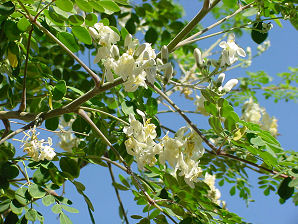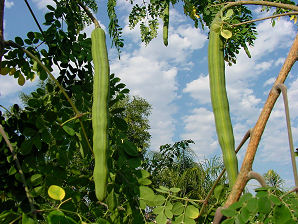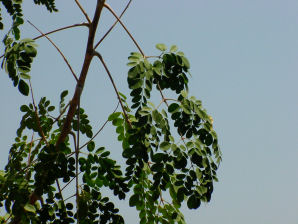Non - Xeriscape.
Common Landscape Plants. Shrubs, Flowers, & Trees.
For The Arizona Desert Environment
Pictures, Photos, Images,
Descriptions, & Reviews.
Moringa, Moringa oleifera.
We Are Proud Of Our SafeSurf Rating!
Click On Any Of The Following Links By Amazon.Com
For Books, & Videos About Wildflowers Of Arizona & The Southwest USA. No Obligation!
 |
| Moringa - Photo June 9, 2005. Three Year Old Tree. Glendale, Arizona. |
|---|
 /
/

Moringa Trees.
We wish to thank Wikipedia, the free encyclopedia for some of the information on this page. We share images and information with Wikipedia. Moringa is a short, slender, deciduous, perennial tree, about 30 feet tall. It is slender with drooping branches; it's branches and stems are brittle with a corky bark. It's leaves are of a feathery nature, green, compound, tripinnate, 10 � 25 inches long, with many small leaflets, 1/4 to 1/2 inches long and about 1/8 to 1/4 inches wide. The lateral leaflets are somewhat elliptic, the terminal one obovate and slightly larger than the lateral ones. It's flowers are fragrant, white to creamy - white, about one inch in diameter, borne in sprays, with five at the top of the flower. The stamens are yellow; the pods pendulous, green to brown, triangular, splitting lengthwise into 3 parts when dry, 15 � 30 inches long, 1 3/4 inches in diameter, containing about 20 seeds embedded in the pith, the pod is tapering at both ends, it is 9-ribbed; the seeds are dark brown, with 3 papery wings. It's main root thick is rather thick. It produces fruit in July in Arizona. Trees of the Moringaceae Family are Acacia - like in habit. A Moringa tree has a tendency to grow up straight and tall putting out leaves and pods at its crown. Moringa is probably the most useful plant in the entire world. Every part of plant can be used for eating, herbal remedies and many other practical applications. The seed is eaten like a peanut in Malaya. The thickened root is used as substitute for horseradish. The foliage eaten as greens, in salads, in vegetable curries, as pickles, and for seasoning. The leaves are ground and used for scrubbing utensils and for cleaning walls. It's seeds yield about 40% of a non-drying oil, known as Ben Oil, used in the arts and for lubricating watches and other delicate machinery. The oil is clear, sweet and odorless, It also is edible and useful in the manufacture of perfumes and hairdressings. Moringa wood yields a blue dye. The leaves and young branches are eated by livestock. Moringa is planted in Africa as a living fence (Hausa) tree. The bark can serve for tanning. Trees planted on graves in Africa keep away hyenas and Moringa branches are charms against witchcraft. It's ground up seeds can also be used to purify water. Moringa's medical uses are many. The flowers, leaves, seeds, and roots are used as folk remedies for tumors. Leaves are applied as a poultice to sores, they are rubbed on the temples for headaches. The bark, leaves and roots are taken to promote digestion. It's oil should not be taken internally, but it is applied externally for skin diseases. It's bark is regarded as an antiscorbic, and it exudes a reddish gum sometimes used for diarrhea. The roots are bitter, act as a tonic to the body and lungs, and are expectorant. They are a mild diuretic and are used as a stimulant in paralytic afflictions, epilepsy and hysteria.
Quick Notes:
Height: Up to 30 feet tall.
Flowers: Fragrant, white to creamy - white, about one inch in diameter, borne in sprays, with five at the top of the flower, with yellow.
Flowering Time: April - September.
Leaves: Green, compound, tripinnate, 10 � 25 inches long, with many small leaflets, 1/4 to 1/2 inches long and about 1/8 to 1/4 inches wide. The lateral leaflets are somewhat elliptic, the terminal one obovate and slightly larger than the lateral ones.
Trunk: 3 to 12 inches in diameter.
Soil pH requirements:
Sun Exposure:
Elevation: Can be found from 0 - 2,500 Feet.
Habitat: Ornamental in lower elevations or Arizona. Not often used, due to its high maintainance.
Miscellaneous: Flowering Photos Taken June 9, 2005 in Glendale, Arizona. Not native to Arizona. These trees are very messy and high maintainance. Not pool friendly. We removed them. These two trees were probably the only ones in Arizona.
|
We Are Proud Of Our SafeSurf Rating!



We Are Proud Of Our SafeSurf Rating!
Click On Any Of The Following Links By Amazon.Com
For Books, & Videos About Xerioscape Plants Of Arizona & The Southwest USA. No Obligation!
| © 1966 - Present, Audrey, Eve, & George DeLange |











